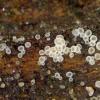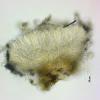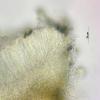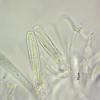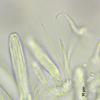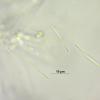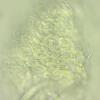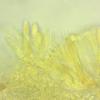
09-11-2025 13:20
Hello.A tiny ascomycete, appearing as erupting gra

08-11-2025 00:29
 Francois Guay
Francois Guay
I found this species in Quebec, Canada, on herbace

04-11-2025 09:07
Hello.A suspected Hymenoscyphus sprouting on a thi

04-11-2025 12:43
 Edvin Johannesen
Edvin Johannesen
Hi! One more found on old Populus tremula log in O

03-11-2025 21:34
 Edvin Johannesen
Edvin Johannesen
These tiny (0.4-0.5 mm diam.), whitish, short-stip
Nouvelle récolte alpine, trouvé sur branches d'Alnus viridis (aulnaie verte à 1'938m), apothécies 0.1 - 0.2 mm, à hyménium blanc, surface externe couverte de petits poils en crochet, renflés à la base, asques à crochets 33 - 38 x 5 - 6 µm, octosporés, IKI-, spores 19 - 27 x 1.25 - 1.5 µm, paraphyses filiformes.
Merci d'avance pour vos avis.
Elisabeth

this is exciting since I just got a sequence from Francois Valade of a fungus that I would say is the same. But it was on Adenostyles stems in French Alpes, 1800 m, and with the ITS I cannot say where it might belong. Mollisina and Phialina come with great distance. For Unguiculella no sequences exist at all, and I am unaware of a species with such spores.
Zotto


Hyalacrotes I know with glassy and hooked paraphysis tips similar to the hairs. And I see in Raitviir 2004 that all of his have this character.
The hairs here in Elisabeth's fungus are not glassy at all but typical Unguiculella.
A sequence of U. eurotioides or another species would be urgent.
Zotto


I recall that hyalacrotes has solid material on the hairs without lumen, and the material disappears in KOH. Here I see a firm but thin wall with a maybe higher refraction index than usual. No, I did not see acute paraphyses, but that feature happens in some of the Ungiculella species.
Zotto

just a question: why not a Hamatocanthoscypha?
Best, Lothar

this is a matter of hair shape. In contrast to Hamatocanthoscypha the hairs have a more glassy wall, and they are often +/- geniculate at the junction of inflated base and narrow part. Besides, as Stip said, the paraphyses are actually hooked and also a bit warted like the hairs. Also the inamyloid asci are frequent in Unguiculella. DNA exists for H. laricionis and I could not recognize a relationship to that.
Zotto

thank you a lot, Zotto!
Best regards, Lothar

that would be great! I will write you in private.


it is a bit old but perhaps worth a try. Mine are also that old.
Zotto


